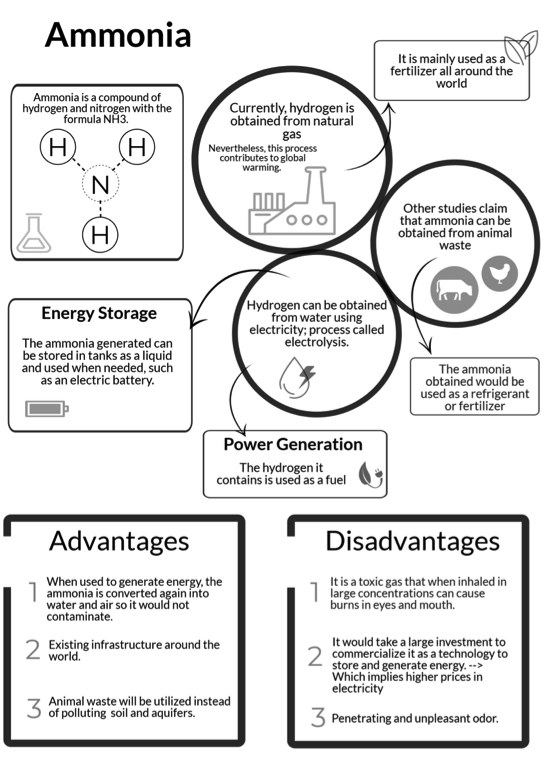Importance of Public Perception towards an Ammonia Economy
By Andrea Mercado-Guati RojoAgustin Valera-Medina on March 01, 2018
A guest post by Andrea Mercado-Guati Rojo and Agustin Valera-Medina, Cardiff University, sharing the conclusions of Mercado-Guati Rojo’s unpublished Master of Science Thesis for her M.Sc Sustainable Energy & Environment, 2017.
During development of the technical aspects of any energy project, a social perspective needs to be considered. Public opinion is going to be a fundamental parameter to determine the role of renewables in the future, with decarbonisation meaning innovation towards a comprehensive plan that involves not only technology but also psychology and how these two can benefit from each other.
Ammonia (NH3) is perceived, by some, as the crucial element for the switch to green alternatives. With its current applications as a fertiliser and chemical compound combined with the knowledge and infrastructure already established, the interest in NH3 is increasing. Due to the versatility of this gas and its advantages over other zero-carbon fuels, the concept of an ammonia system has exceptional potential for the future. Furthermore, it represents an opportunity for developing countries already involved in ammonia production through agriculture.
Due to the importance of understanding public perception of ammonia, Cardiff University conducted a study focused on the Yucatan Peninsula, Mexico, which currently presents high revenues in agriculture and depends on ammonia as a fertiliser. An analysis of stakeholder’s perception of ammonia was carried out to understand the different barriers and drivers of each established group (government, people involved with cattle animals, and general public) following the research question: “What are people’s initial responses when presented the idea of ammonia as an energy vector.”
The results revealed that while the Mexican government is not currently interested in an ammonia system due to the initial cost and the lack of development in other countries, general population and people in the livestock industry are keen to help in the advancement of these systems via investment on the concept. Currently, Mexico imports 65% of its ammonia from the United States. However, its low cost and the investment that would be required in new infrastructure make it almost impossible to change to local production from renewables. Surveyed people admitted that all the projects to obtain ammonia from clean sources were interesting. However, they were concerned not about the toxicity of the gas, but about the cost of introducing the technology into the local market. What would change their minds? A technology that offers the same price as natural gas but with better performance.
The study applied a multi-methodological approach with a sample of 50 questionnaires and 7 interviews to people in the Mexican Government and people involved with cattle animals. The surveys were based on the initial responses before and after providing information about ammonia.
Of the 76% of people with an initial negative perceptive about the gas, 96% changed their opinion after being presented with an infographic with technical information, proving that the main barrier with general population for a technology like ammonia is the lack of information.

On the other hand, during the analysis of other barriers, it was clear that the negative perception revolves around the impression that ammonia is a “dangerous gas,” a main concern of the public. Interestingly, regions far from the grid and in farmlands showed a highly positive perception of the use of ammonia as energy vector, while urban areas were concerned about the smell of the gas. It is important to highlight that most of the people interviewed affirmed that they are willing to pass over the fear of using ammonia if the gas proves to be beneficial for the environment and proper health and safety systems are implemented.
This study presents this information as a first step towards the understanding of public perception surrounding the use of ammonia as energy vector. However, in order to draw definitive conclusions and be able to complete the research with a comparison between the UK and Mexico, the School of Psychology from Cardiff University will be conducting further studies to provide an extensive opportunity to examine potential deployment of ammonia projects in two different contexts. The project will examine similarities and differences, as well as their drivers.
A guest post by Andrea Mercado-Guati Rojo and Agustin Valera-Medina, Cardiff University, sharing the conclusions of Mercado-Guati Rojo’s unpublished Master of Science Thesis for her M.Sc Sustainable Energy & Environment, 2017.